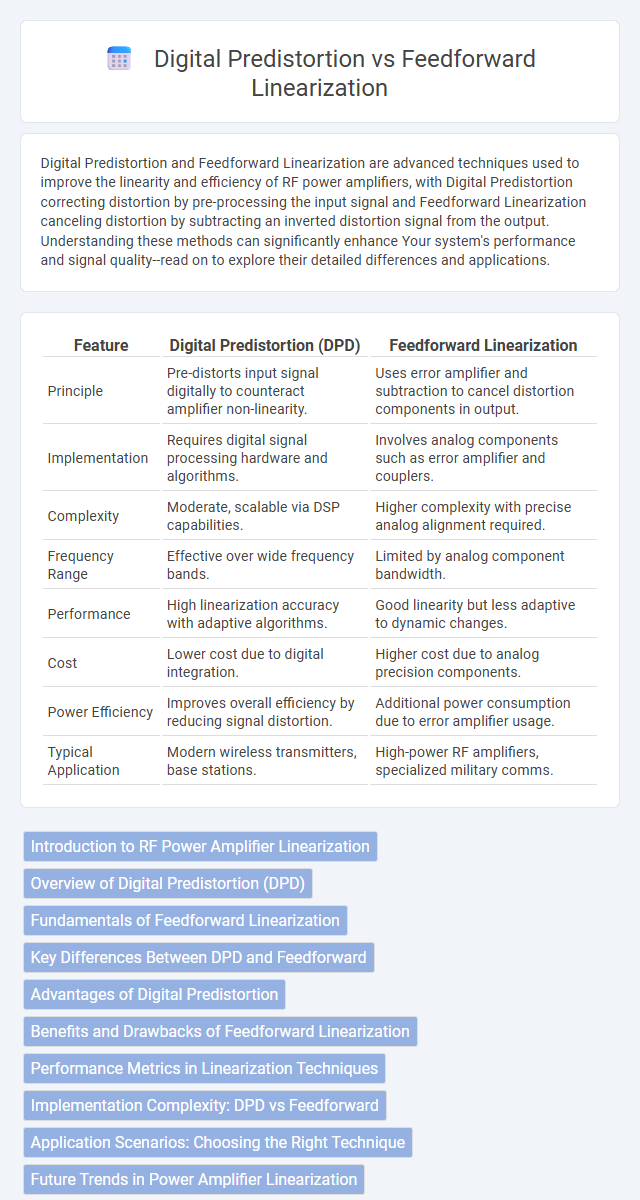Digital Predistortion and Feedforward Linearization are advanced techniques used to improve the linearity and efficiency of RF power amplifiers, with Digital Predistortion correcting distortion by pre-processing the input signal and Feedforward Linearization canceling distortion by subtracting an inverted distortion signal from the output. Understanding these methods can significantly enhance Your system's performance and signal quality--read on to explore their detailed differences and applications.
Table of Comparison
| Feature | Digital Predistortion (DPD) | Feedforward Linearization |
|---|---|---|
| Principle | Pre-distorts input signal digitally to counteract amplifier non-linearity. | Uses error amplifier and subtraction to cancel distortion components in output. |
| Implementation | Requires digital signal processing hardware and algorithms. | Involves analog components such as error amplifier and couplers. |
| Complexity | Moderate, scalable via DSP capabilities. | Higher complexity with precise analog alignment required. |
| Frequency Range | Effective over wide frequency bands. | Limited by analog component bandwidth. |
| Performance | High linearization accuracy with adaptive algorithms. | Good linearity but less adaptive to dynamic changes. |
| Cost | Lower cost due to digital integration. | Higher cost due to analog precision components. |
| Power Efficiency | Improves overall efficiency by reducing signal distortion. | Additional power consumption due to error amplifier usage. |
| Typical Application | Modern wireless transmitters, base stations. | High-power RF amplifiers, specialized military comms. |
Introduction to RF Power Amplifier Linearization
RF power amplifier linearization is crucial for improving signal quality and efficiency in wireless communication systems. Digital predistortion (DPD) compensates for amplifier non-linearities by applying an inverse distortion to the input signal, enhancing linearity with minimal hardware changes. Feedforward linearization uses error cancellation loops to suppress distortion components, offering high linearity at the expense of increased system complexity and power consumption.
Overview of Digital Predistortion (DPD)
Digital Predistortion (DPD) is a technique used to improve the linearity of power amplifiers by pre-processing the input signal with an inverse distortion function, effectively minimizing nonlinear effects and intermodulation distortion. This approach enables high-efficiency operation of RF power amplifiers in wireless communication systems by compensating for amplitude and phase distortion. DPD algorithms rely on adaptive modeling and real-time feedback to dynamically adjust the predistortion function, ensuring optimal signal fidelity and spectral efficiency.
Fundamentals of Feedforward Linearization
Feedforward linearization eliminates distortion by generating an error signal through a secondary amplifier, which is then subtracted from the output to cancel unwanted nonlinearities. This method fundamentally relies on creating a correction path that directly compensates for the power amplifier's nonlinear behavior. Your system's performance improves by effectively isolating and removing distortion components without altering the main signal path.
Key Differences Between DPD and Feedforward
Digital Predistortion (DPD) primarily uses a nonlinear function to counteract power amplifier (PA) distortions before signal transmission, enhancing efficiency and linearity. Feedforward linearization employs an error-cancellation loop to subtract distortion components from the output signal, offering precise distortion correction but increased complexity. DPD is favored for real-time processing in modern communication systems, while feedforward suits high-power applications demanding exceptional linearity despite higher hardware requirements.
Advantages of Digital Predistortion
Digital Predistortion (DPD) offers significant advantages over Feedforward Linearization by providing higher efficiency and adaptability in power amplifier linearization for wireless communication systems. DPD compensates for distortion before amplification, enabling improved signal quality and reduced spectral regrowth, which enhances overall network performance and battery life in mobile devices. By applying advanced algorithms, Your system benefits from real-time correction of nonlinearities, leading to more consistent and reliable signal transmission compared to the more complex and less flexible feedforward approach.
Benefits and Drawbacks of Feedforward Linearization
Feedforward linearization offers high linearity improvement and effective distortion cancellation by using a separate distortion path to correct amplifier output signals, making it suitable for high-power RF amplifiers in communication systems. However, it involves complex circuitry, higher power consumption, and increased system cost, which can limit integration in compact or low-power applications. Your choice depends on balancing these benefits against system complexity and power efficiency requirements.
Performance Metrics in Linearization Techniques
Digital Predistortion (DPD) and Feedforward Linearization are evaluated using key performance metrics like Adjacent Channel Power Ratio (ACPR), Error Vector Magnitude (EVM), and Total Harmonic Distortion (THD). DPD typically achieves superior ACPR reduction and EVM improvement due to its adaptive capability in compensating nonlinearities in real-time. In contrast, Feedforward Linearization excels in THD suppression but often demands higher hardware complexity and power consumption.
Implementation Complexity: DPD vs Feedforward
Digital Predistortion (DPD) offers lower implementation complexity compared to Feedforward Linearization, as it primarily requires adaptive algorithms and digital signal processing without the need for additional analog components. Feedforward Linearization demands complex analog circuitry, such as error amplifiers and delay elements, increasing design intricacy and calibration needs. The software-centric nature of DPD enables easier integration with modern transmitters and facilitates real-time adaptation to nonlinearities.
Application Scenarios: Choosing the Right Technique
Digital predistortion (DPD) excels in modern wireless communication systems like LTE and 5G for efficiently compensating power amplifier nonlinearities in real-time, making it ideal for high-linearity, wideband signals. Feedforward linearization is better suited for applications requiring ultra-high linearity and broadband distortion correction, such as satellite communications and radar systems, where higher complexity and cost are justified. Selecting the right technique depends on system requirements including bandwidth, linearity needs, power efficiency, and hardware complexity constraints.
Future Trends in Power Amplifier Linearization
Digital Predistortion (DPD) and Feedforward Linearization are key techniques shaping future trends in power amplifier linearization, driven by the need for higher efficiency and spectral purity in 5G and beyond communication systems. Advances in machine learning algorithms and real-time adaptive processing are enhancing DPD capabilities, enabling more precise compensation for amplifier nonlinearities and reducing out-of-band emissions. Your choice between these methods depends on application complexity, with DPD increasingly favored in modern wireless systems due to its scalability and integration with digital signal processors.
Digital Predistortion vs Feedforward Linearization Infographic

 electrown.com
electrown.com